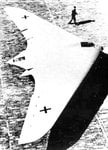RonRyan85
Airman
What is the story on the WW2 Horten Brothers flying wings that
were first built as gliders in 1930? And were almost made with
jet engines toward the end of the war. Never finished as the
war ended too soon for Germany....what happened to make the
futuristic swept back wing designs so long in development? Did
the Germans distrust the Hortens?
Did the aircraft need jet engines that were more powerful? Lucky
for the Allies that Germany ran out of gasoline,pilots and
everything else as this design may have proved to be a great
"Wonder Weapon". Anyone have any comments?
were first built as gliders in 1930? And were almost made with
jet engines toward the end of the war. Never finished as the
war ended too soon for Germany....what happened to make the
futuristic swept back wing designs so long in development? Did
the Germans distrust the Hortens?
Did the aircraft need jet engines that were more powerful? Lucky
for the Allies that Germany ran out of gasoline,pilots and
everything else as this design may have proved to be a great
"Wonder Weapon". Anyone have any comments?


